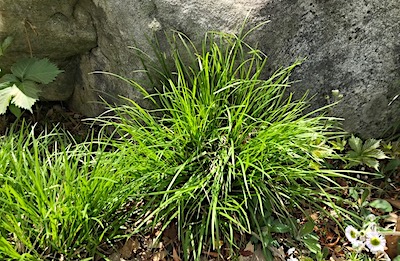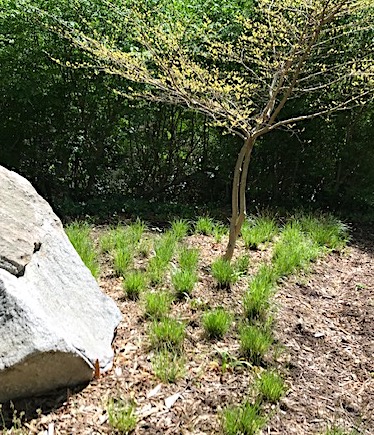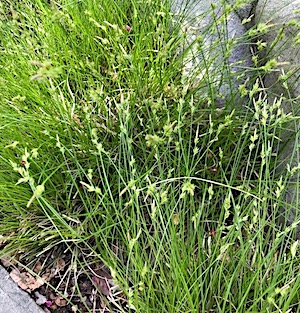Satisfying Sedges
by Gretchen Spencer, former Fairfax Master Gardener

Carex amphibola narrowleaf sedge in woodland setting
Sedges have been gaining prominence in the plant world, especially with the emphasis on using native plants in the garden. Unlike the pesky yellow nutsedge, a weed that invades our agricultural crops and landscapes, these sedges add value to the garden. Their value lies in their great diversity, low maintenance, benefit to wildlife and adaptability to a range of habitats. Additionally, most are evergreen or semi-evergreen, a plus in the garden.
These grass-like perennials belong to the family Cyperaceae, which contains the true grasses, sedges, rushes, restios and cattails. All these plants have long, narrow leaves. Sedges are in the genus Carex. This huge genus has over 1,500 species. The name Carex originates from Latin and means cutter, as most sedges have sharp leaves and stem edges. Sedges are easily identified by their sturdy triangular stems. As an old botanical rhyme reminds us, “Sedges have edges, rushes are round and grasses are hollow like a hole in the ground.”

Sedges in a natural landscape
Sedges have fibrous roots and, while some grow in distinct clumps, most spread by rhizomes or stolons. Thus, sedges can cover extensive areas. The flowers on sedges are small and insignificant. They often occur in spikelets with both male and female flowers on a single plant. While the flowers are insignificant, they add texture and color to the plants. All sedges are pollinated by the wind.
Sedges are found throughout the world, usually in moist, wet or swampy conditions. However, there are species that will thrive in hot, dry environments. While most species prefer sunny locations, others will grow in the shade. And although many sedges prefer acidic or slightly acidic soils, there are some that will grow in alkaline soils. Their adaptability to a range of growing conditions contributes to their usefulness in the garden.
I have a small planting of Pennsylvania sedge (C. pensylvanica) that is just taking hold in a small bed with astilbe and creeping phlox. My neighbor has a larger planting of Pennsylvania sedge growing in a small bed around a large rock and crape myrtle. The narrow, arching, jade-green leaves contrast nicely with the wooded setting. C. pensylvanica grows between 6 and 12 inches, in full sun to full shade. It thrives in dry as well as moist soils. According to Plant NoVA Natives, it enriches the soil and attracts birds.

Carex pensylvanica Pennsylvania sedge in landscape
I took a trip to the U.S. Botanic Garden where I found several kinds of sedges that demonstrate their variety, color, texture, form and beauty. There were several patches of eastern narrowleaf sedge, C. amphibola, nestled among some rocks and other native plants. There was also plantainleaf sedge, C. plantaginea. This sedge had slightly wider leaves and delicate creamy flower spikes growing alongside some purple dwarf iris. C. albicans, whitetinge sedge, a low-growing clump-forming sedge, was covered with tiny white flowers. Most dramatic at the Botanic Garden was a mature, handsome patch of Pennsylvania sedge that carpeted the ground under a tree.
Sedges work well in woodland gardens or rock gardens. They can also make good groundcovers when they are established. Sedges can be used in place of invasive English ivy, periwinkle or liriope. They add texture and form to the garden and work well with other perennials. As many species prefer moisture, they do well in those tricky wet areas of the garden or yard.

Carex albicans Whitetinge sedge, a low-growing, clump forming variety
While there are sedges available from other parts of the world, the native sedges mentioned here have wildlife value. Many are host plants for skipper butterfly larvae. The native broad-leaved sedge, C. platyphylla, hosts over 35 species of native caterpillars. There are an amazing variety of sedges. Suitable to nearly any setting, these low-maintenance plants, relatively free of disease or insects, can provide satisfaction in the garden.
References
• Native Sedges for Gardening, Scott Woodbury, Missouri
Botanical Garden
• Carex pensylvanica, Missouri Botanical Garden
• The Encyclopedia of Grasses for Livable Landscapes, by
Rick Darke, 2007
• Ornamental Grasses for the Southeast, by Peter Loewer, 2003
• Native Plants for Northern Virginia, Plant NoVA Natives Campaign
…updated 2023